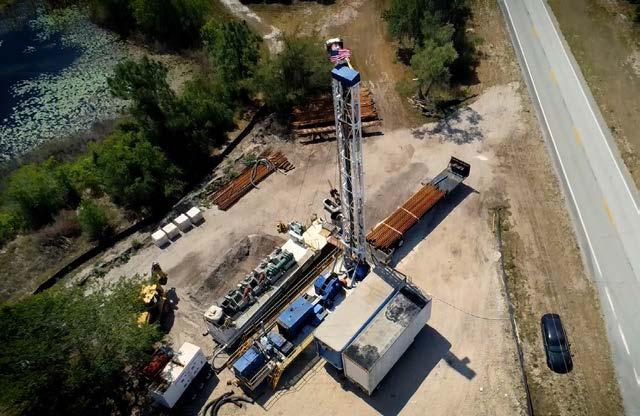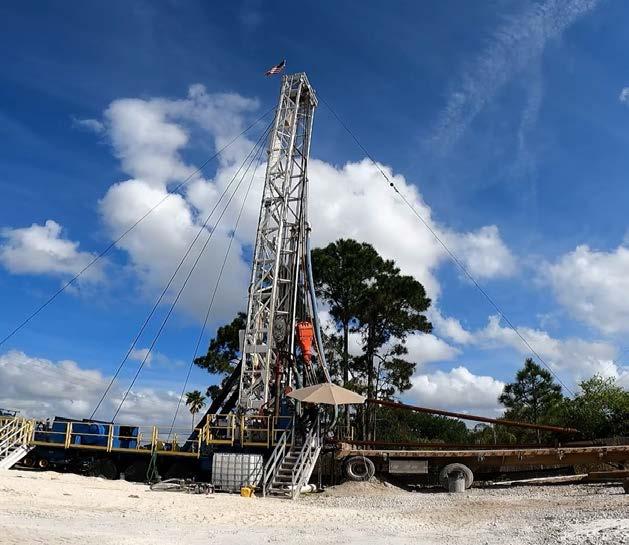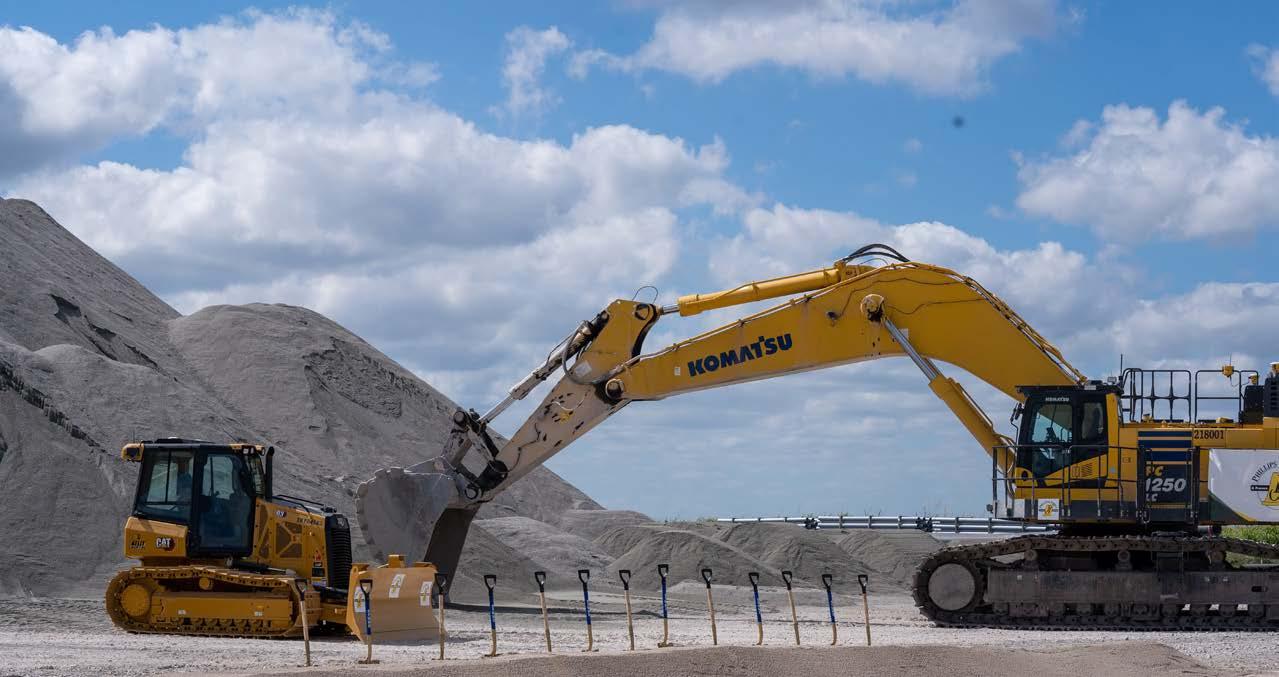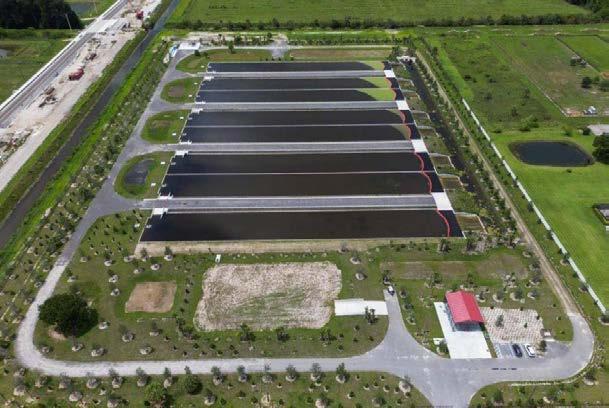
14 minute read
From Restoration to Exploration, Florida Puts Focus on Water Resources
BY JOE VANHOOSE Managing Editor
The Southwest Florida Water Management District (SWFWMD), one of five districts in the state, has long focused on educating the end user about springs, aquifers and clean water. In Sarasota, that looks like targeted social media campaigns, flyers in parks and at kayak rental stands, and even educational coasters used at many seaside restaurants. For the millions of tourists who come to Florida every year to enjoy its water bodies, SWFWMD has found a receptive audience.
“You can see the water here – you can touch it,” SWFWMD Executive Brian Armstrong said. “It’s easier to explain aquifer levels and flows and springs and their importance when you can look out and see what you want to protect.”
You can see the water here –you can touch it. It’s easier to explain ... when you can look out and see what you want to protect.
Protection and production are top of mind for water resources officials around the state as record numbers of residents and visitors continue to flock to Florida. With the growth and development come old threats to Florida’s springs, bays and waterways, as well as new ideas on how to ensure the state has clean, plentiful water for generations to come.
A Melbourne native, Armstrong started as a field tech with the SWFWMD in 1997. When it comes to water supply, Armstrong is confident that agencies and districts like his across Florida are making the necessary investments now to solve water crises before they could happen.
“I am not really concerned because I know the water supply authorities are out there planning not just 20 years but 40 to 60 years ahead,” Armstrong said. For instance, in his district, the Peace River Manasota Regional Water Supply Authority is constructing its third off-stream reservoir at the Peace River Treatment Facility in DeSoto County. The 9.3-billion-gallon reservoir will capture and store excess flows from the Peace River during the rainy season, which will increase reliability of the region’s water supply.
Tampa Bay Water is building the South Hillsborough pipeline to deliver an estimated 65 million gallons per day of alternative water supplies to the growing Boyette, Wimauma and Balm areas. The pipeline will start at the Tampa Bay Regional Surface Water Treatment Plant in Brandon and connect to Hillsborough County’s Lithia Water Treatment Plant. As far as finding new water sources, Polk County is going deeper.
DRILLING TO THE LOWER AQUIFER
Over the past decade, Polk County has become the fastest-growing county in the state. Its population ballooned from around 600,000 in 2010 to nearly 800,000 residents by the end of 2022.
Along with that growth have come growing concerns about where the water will come from to fulfill the heightened demand. To ensure capacity, the Polk Regional Water Cooperative began drilling new super wells east of Lake Wales and in Lakeland earlier this year that will penetrate two times deeper and tap into the Lower Floridan Aquifer.
The Lower Floridan Aquifer is much different than the upper aquifer used by most of Florida, which produces water that is close to drinkable as-is. The lower aquifer is much more brackish, requiring treatment via reverse osmosis. Still, once the wellfields are operational in the coming years, they will deliver up to a combined 22 million gallons per day of high-quality drinking water to the member governments.
These projects and others like it will take several years and hundreds of millions of dollars – even billions – to develop, which is why the water management districts are looking so far into the future, Armstrong said.
“When you get a great idea for an alternative water supply, it takes about 10 years before that water is going through someone’s tap,” he said. “So we must look well into the horizon. When you’re planning, if you need 100 million gallons per day, you plan for 300.”
RESTORING BAY WATERS
David Tomasko spent 11 years with SWFWMD as a senior scientist and environmental manager before working with Atkins and Environmental Science Associates for a decade. He returned to Southwest Florida to become Director of the Sarasota Bay Estuary Program (SBEP) in November 2020.

He arrived with a five-year plan for making an impact. "If we can’t do it in five years, I am out because I don’t think we have more than five years,” he said.
SBEP’s Health of the Bay Report measures more than just water quality, instead looking at the health of the entire ecosystem. Volunteers visited 55 sites and drew over 500 data points, measuring nitrogen concentration along with dissolved organic nitrogen, algae and macroalgae. Paired with seagrass mapping from the SWFWMD, the report card compares each segment of Sarasota Bay against itself from years past.
“It becomes clear that, from 2006 to 2012, this was a healthier bay,” Tomasko said. “We’re talking lower nitrogen, less algae, clearer water, a 28% increase in seagrass [the peak for seagrass was in 2016].”
Several projects are lined up with a goal to return Sarasota Bay’s water quality to those 2006-2012 numbers, Tomasko said. Advanced water treatment, removing septic tanks from the watershed, and removing present and future spills will all help make a path to a better Bay.
It’s happened before. Tampa Bay experienced a 70% increase in seagrass coverage between 1999 and 2016. The biggest asset to its recovery was the City of Tampa’s wastewater treatment plant upgrade. Tampa Bay Water’s Regional Surface Water Treatment Plant has operated successfully since 2002, providing up to 90 million gallons per day of high-quality drinking water to the region and a maximum of 120 million gallons per day.
“But if you look at a big reason why they did it, it wasn't all about seagrass and water clarity, it’s the focus on macroalgae that had gone up around wealthier neighborhoods in South Tampa," Tomasko said.
“Waterfront property owners are the first ones to have their property values impacted by bad water. They have the most to lose, so they have the most reason to push to do more than what we’re doing.”

“Waterfront property owners are the first ones to have their property values impacted by bad water. They have the most to lose, so they have the most reason to push to do more than what we’re doing.”
Another big reason is to protect Florida’s tourism industry, which depends greatly on the state’s environmental assets.
“Our tourist industry depends on a healthy environment when it comes to the outdoors,” Armstrong said. “You have birdwatchers, kayakers, fishermen, all these activities that highlight our water resources. That’s why it is imperative to maintain their health.”
As far as the health of the Sarasota Bay watershed, 2018 was the worst year on record for wastewater overflows, as significantly more rain than usual primed the bay full of stormwater runoff.
“The water gets warm and we had the worst year for overflows and we had the worst red tide,” Tomasko said. “At the same time, you had the manatee dieoff in Indian River Lagoon – we’ve lost 20-30 percent of the statewide manatee population in the last three years.”
Seagrass loss, evident from Indian River Lagoon to Biscayne Bay to Sarasota, Tampa and Lemon Bays, is the biggest culprit, Tomasko said. Combined, Florida’s waterways have lost more than 150 square miles of seagrass habitat.
“Manatees are dying because they’re starving, and they’re starving because there’s no seagrass, and there’s no seagrass because the water quality has gotten so bad in Indian River Lagoon and other areas,” he said. The loss of seagrass could have been because of a perfect storm of nutrient loads reaching a tipping point, red tide, algae, big storms and more rainfall over the last 10 years than previous 10 years, Armstrong said. There is no silver bullet to recovery.
“That keeps me a little worried,” Armstrong said. “I don’t have a doubt that we have some very intelligent people working on it from the (water management) districts and estuary programs. Everyone loves the Gulf and the Bays, and we’re all in it together to take care of them, even the private sector.”
Likewise, Tomasko remains optimistic about a turnaround in Florida’s seagrass recovery, as well as its focus on maintaining and restoring its water resources.
“I think I am optimistic because what’s the alternative?” Tomasko said, but he has more reason to believe than just shutting out the worst-case scenario. Development in his district is occurring farther away from the coast, and new development also has stronger rules and regulations to follow now than ever before.
Sarasota County is already moving forward with an expansion of its Bee Ridge Water Reclamation Facility, converting it to an Advanced Wastewater Treatment (AWT) facility. The project broke ground last year. The converted AWT will remove significant amounts of nitrogen and phosphorus in the effluent, provide higher quality reclaimed water for irrigation that conserves potable drinking water and ultimately help recharge the Florida aquifer.
Manatees are dying because they’re starving, and they’re starving because there’s no seagrass, and there’s no seagrass because the water quality has gotten so bad.
To hold the line on harmful nutrients and restore waterways across Florida, Tomasko prescribes two key tactics.
“First, we need to minimize the increase in nutrients from new development,” he said. “But we have to also retrofit the older neighborhoods.
“When you come to Sarasota or Tampa around the older neighborhoods, there aren’t stormwater ponds, you have curbs and gutters – rain comes off the roof, goes down the street, through the drain and right out to the bay. So old development needs to be brought to a better level of treatment.”
Evidence of prioritizing Florida’s natural water resources amidst the state’s population growth is popping up in other key regions, too.
EVERGLADES RESTORATION ADVANCES
In February, the U.S. Army Corps of Engineers (USACE) and the South Florida Water Management District (SFWMD) broke ground on the reservoir component of the Everglades Agricultural Area (EAA) Reservoir Project.
USACE is constructing the 10,500-acre reservoir that can store up to 240,000 acre-feet in static water storage. In conjunction with other Central Everglades Planning Project (CEPP) features, this project will deliver an annual average of 360,000 acre-feet of clean water south to the Everglades. Meanwhile, SFWMD will finish construction on the adjoining 6,500-acre constructed wetland stormwater treatment area this year. The wetland will use three separate treatment cells of aquatic vegetation to remove nutrient pollution and clean water before it flows south into the Everglades.
“Many consider this project to be the 'crown jewel' of the Comprehensive Everglades Restoration Plan,” said Col. James Booth, commander of the U.S. Army Corps of Engineers Jacksonville District, at the reservoir groundbreaking. “The (EAA) Reservoir and Stormwater Treatment Area phase of the Central Everglades Planning Project is the keystone that deliberately reconnects Lake Okeechobee to the Everglades. Today’s success is due to the collaboration of federal, tribal, state and local partners.”
Florida Gov. Ron DeSantis has made water in general and Everglades restoration in particular one of the priorities of his administration. During his first term, SFWMD moved more than 50 Everglades projects forward. In January, DeSantis signed Executive Order 23-06 (Achieving Even More Now for Florida’s Environment), with a proposed $3.5 billion investment over four years for Everglades restoration and protection of the state’s water resources, surpassing the historic investments of the past four years and making it the highest level of funding in Florida’s history.

The USACE and SFWMD are 50/50 partners in implementing the world's most ambitious ecosystem restoration effort: the Comprehensive Everglades Restoration Plan (CERP). The EAA Reservoir Project is a key component of CEPP, a suite of projects within CERP to restore the Everglades and send more water south.
INDIAN RIVER LAGOON TAKES FOCUS
Another key CERP project spans both the South and St. Johns Water Management Districts. The Indian River Lagoon, home to more than 3,000 species of plants and animals, is considered the most biologically diverse estuarine system in the continental United States. It spans 156 miles from Ponce de Leon Inlet in Volusia County to the southern boundary of Martin County, the lagoon supporting commercial and recreational fisheries and acts as a $7.6 billion economic engine for the region.
But the waterbody has been plagued by harmful algal blooms resulting from decades of human impacts, specifically from nutrients from stormwater runoff, drainage canals and other sources.
In Martin County, the C-44 Reservoir and Stormwater Treatment Area under construction is the first component of the multi-billion dollar Indian River Lagoon-South restoration project. C-44 includes the construction of a 3,400-acre reservoir, a pump station with a capacity to pump 1,100 cubic feet per second of water, and 6,300 acres of stormwater treatment area.
All project components were originally planned to be built by the U.S. Army Corps of Engineers, but SFWMD awarded construction contracts for the pump station, stormwater treatment area and system discharge canal.
After construction is completed, the project will capture local runoff from the C-44 basin, reducing average annual total nutrient loads and improving salinity in the St. Lucie Estuary and the southern portion of the Indian River Lagoon. In total, it will provide 60,500 acre-feet of new water storage and 3,600 acres of new wetlands.
To the north, the St. Johns River Water Management District (SJRWMD) has awarded nearly $40 million for projects in Indian River Lagoon communities, leveraging a total of $81 million in public dollars when combined with local matching funds and state funds from the DEP.
“As we continue to implement projects to restore iconic watersheds like the Indian River Lagoon, I am reminded of the unprecedented level of support secured under the DeSantis administration for Florida’s environment,” said Florida Department of Environmental Protection (DEP) Secretary Shawn Hamilton in July at a kickoff for three Indian River Lagoon Projects. “This session, legislation passed establishing the Indian River Lagoon Protection Program and $100 million in funding was dedicated to support water quality improvement projects in this critical waterbody. We look forward to working with our partners to further our ongoing commitment to restoring the Indian River Lagoon.”
The Crane Creek / M-1 Canal flow restoration project is a SJRWMD-led project approved by its governing board in January. The M-1 Canal was developed over 100 years ago to redirect stormwater from 5,300 acres near the St. Johns River to the Indian River Lagoon.

Along with the millions of gallons of water came thousands of pounds of harmful nutrients, including nitrogen and phosphorus.
Once complete, the project will restore the natural flow of the stormwater from the IRL back west, where the water will be treated in a stormwater treatment area prior to reaching the St. Johns River.
Moorhen Marsh, which was jointly funded with DEP and Indian River County, is an aquatic plant-based treatment system that treats stormwater runoff from a 6,300-acre area. Capable of pumping and treating 10 million gallons per day, the project will reduce the amount of total nitrogen by 4,854 pounds per year (lbs/year) and total phosphorus by 785 lbs/ year.
The Ponce De Leon Circle Septic-to-Sewer project in Volusia County included the construction of gravity sewer, force main, manholes, a lift station and abandonment of up to 24 septic tanks with connection to sanitary sewer in the town of Ponce Inlet.
Taken as a whole, Armstrong looks around the state and feels positive about the impact the water management districts, DEP and local counties and municipalities are making. To keep Florida’s water clean and plentiful will take all hands on deck.
“The five of us (districts) get along really well to the point that, if a district is doing something well, we can ask how they did and help figure things out,” Armstrong said. “We all work with DEP the same way.
“Right now we have a really good group of folks in leadership, and there’s no turf war. We want to find the best ways to move Florida forward.”







